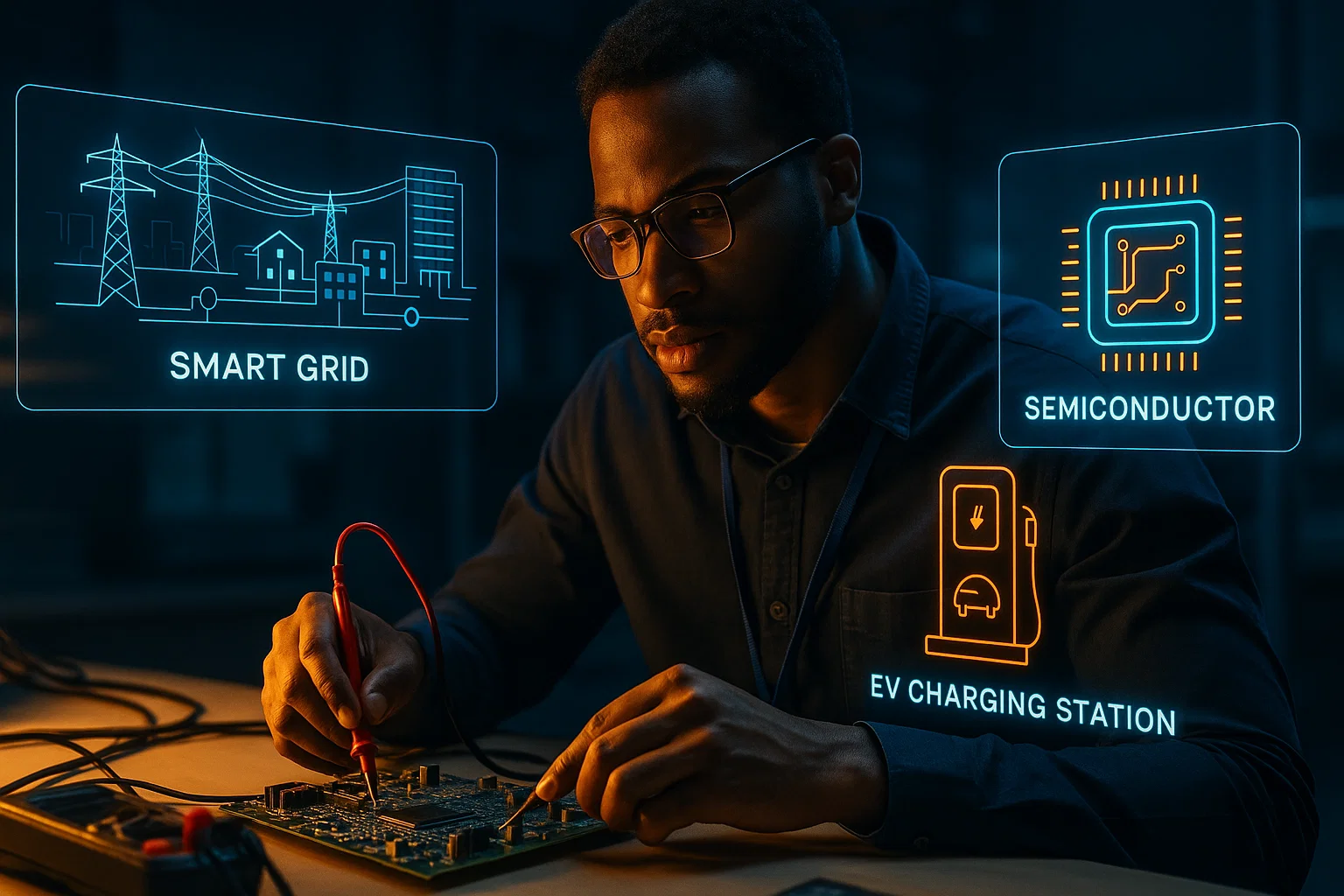Emerging trends in electrical engineering are reshaping how power is generated, managed, and consumed, with smart grids, EVs, IoT sensors, and AI-driven control leading the change—this article gives practical steps, tools, and compliance tips so you can apply them today.
Introduction
Emerging trends in electrical engineering are reshaping projects from grid control to product sensors, and this is an informational guide to help you spot opportunities and apply them. I’ll show what matters (smart grids, power electronics, IoT, AI, EV integration), why it matters for engineers and teams, and practical steps you can use right away. Expect hands-on examples, a short Python code snippet, tool picks, and a compliance checklist. Early signals from industry reporting and engineering societies show strong momentum for electrification, AI for power, and sensor-driven operations, so you’ll get context plus actionable steps that a practitioner can follow.
What “emerging trends in electrical engineering” really means, and why it matters
The phrase “emerging trends in electrical engineering” refers to the cluster of technologies and practices changing how electrical systems are designed, operated, and maintained. That includes power electronics improvements, grid digitization (smart grids), renewable integration, electric vehicles, IoT sensing, and AI-driven system optimization.
The technical backbone
Power electronics is the glue that makes renewables, EV chargers, and efficient motor drives possible. Organizations focused on power engineering highlight a move toward modernizing curricula and R&D to include power electronics and renewable interconnection. IEEE Spectrum
Why you should care
Energy systems are more stressed and more valuable to businesses. Grid operators and tech companies adopt AI and automation to speed planning and interconnection, which changes the skillset engineers need and the architecture teams build. Recent reporting shows major grid operators partnering with AI providers to automate planning tasks and speed interconnection decisions. Reuters
Smart energy systems and AI are being used to speed grid planning, automating tasks that were manual before (IEEE, paraphrased). (IEEE Spectrum)
Market signals
Sensor networks and EV-related hardware are growing fast, so hardware designers and embedded teams will find steady demand for sensor-driven solutions and EV power systems. Market data points to strong growth in IoT sensors and EV sensor markets. Global Market Insights Inc.
How to apply these trends: step-by-step guide and real-world examples
Follow these steps to prototype a small, practical project that leverages emerging trends in electrical engineering: build a smart IoT energy monitor that pushes data to the cloud and runs a simple ML model for anomaly detection.
- Define the scope and KPIs
- Pick one circuit, one meter, and measurable goals, for example reduce peak load by 10% or detect 90% of abnormal draws within one minute.
- Choose hardware and sensors
- Select a power measurement IC (or a smart meter), a microcontroller with edge ML support, and an MQTT-capable network module.
- Prototype sensor read and publish
- Use the Python example below to read a sensor stream (simulated) and publish to an MQTT topic.
# python
# Simple simulator: read power values and publish to MQTT
import time
import json
import random
import paho.mqtt.client as mqtt
BROKER = "mqtt.example.local"
TOPIC = "building/1/power"
def read_sensor():
# simulate power readings in watts
return round(300 + random.uniform(-50, 200), 2)
def main():
client = mqtt.Client()
try:
client.connect(BROKER)
except Exception as e:
print("MQTT connect failed:", e)
return
client.loop_start()
try:
while True:
value = read_sensor()
payload = json.dumps({"power_w": value, "ts": time.time()})
client.publish(TOPIC, payload)
time.sleep(5) # publish every 5 seconds
except KeyboardInterrupt:
client.loop_stop()
client.disconnect()
if __name__ == "__main__":
main()
Explanation: this code simulates sensor readings and publishes them to MQTT. Replace read_sensor() with real ADC or power IC readings and secure your broker for production.
- Add an edge ML rule
- Run a lightweight anomaly detector (threshold or simple model) on the device to reduce cloud cost and reaction time.
- Integrate with cloud and control
- Use cloud functions to aggregate and feed signals into control loops, demand response, or logging dashboards. For grid-scale or enterprise systems, coordinate with the utility for safe interconnection and policies. Recent industry projects show utilities integrating AI to manage interconnection queues and planning, demonstrating this is production-capable. Reuters
- Test and iterate
- Apply staged rollouts: lab → pilot → production, and collect real-world telemetry to refine thresholds and models.
Best practices, recommended tools, pros and cons
Best practices
- Design for observability from day one, including timestamps and device IDs.
- Use secure transport for telemetry (TLS, certificate-based auth).
- Implement firmware OTA updates with fail-safe rollbacks.
- Keep safety interlocks in hardware, never rely solely on software.
Top tool recommendations
- MQTT + Mosquitto
- Pros: lightweight, simple to deploy.
- Cons: needs secure configuration for production.
- Install tip:
apt install mosquittoor use Docker image for quick starts. Global Market Insights Inc.
- Edge ML: TensorFlow Lite
- Pros: portable, supported on many MCUs.
- Cons: model optimization may be required for constrained devices.
- Start tip: use the TFLite Micro examples for microcontrollers.
- Power electronics simulation: LTspice or PLECS
- Pros: accurate circuit simulation for design validation.
- Cons: learning curve for advanced topologies.
- Start tip: prototype converter stages in LTspice, verify switching behavior before PCB.
Pros and cons of trend adoption
- Pros: efficiency gains, new product features, competitive advantage.
- Cons: integration complexity, supply chain sensitivity for semiconductors, and added compliance work.
Challenges, legal and ethical considerations, troubleshooting
Common challenges
- Interoperability between vendor devices and legacy systems.
- Managing high-power equipment safety during testing.
- Guaranteeing data privacy for user energy data.
Compliance checklist
- Ensure device firmware and cloud services meet local privacy laws.
- Use secure identity and access control for device management.
- Verify interconnection rules with the local grid operator before automated control.
- Keep logs and change records for audits.
Troubleshooting quick tips
- If telemetry drops, check certificate expiration and broker logs.
- If measurements are noisy, shield ADC lines and add RC filtering.
- If control commands are delayed, profile network latency and move simple rules to edge.
Grid operators and engineering societies emphasize modernizing grid tools and training to handle electrification and power-electronics demands (Deloitte, paraphrased). (Deloitte) Deloitte
Alternatives
If full integration is risky, deploy passive monitoring first, then add closed-loop control after a verified pilot.
Compliance/disclaimer
This article is informational and does not replace legal or professional compliance advice. If you handle customer data or grid control, consult a qualified professional for privacy, ToS, and regulatory compliance such as GDPR or CCPA.
Conclusion and CTA
Emerging trends in electrical engineering give you a toolkit to build smarter power systems, faster prototypes, and safer products. Start small: instrument one circuit, add secure telemetry, and evaluate the ROI of edge intelligence. If you want help building a pilot, Welcome to Alamcer, a tech-focused platform created to share practical knowledge, free resources, and bot templates. Our goal is to make technology simple, accessible, and useful for everyone. We provide free knowledge articles and guides in technology, offer ready-to-use bot templates for automation and productivity, and deliver insights to help developers, freelancers, and businesses. Custom development services for bots and websites are available on request—reach out and we’ll help you move from prototype to product.
FAQs
What is emerging trends in electrical engineering?
Emerging trends in electrical engineering refers to the set of developing technologies and practices—like smart grids, power electronics improvements, IoT sensors, EV integration, and AI for power systems—that are changing how electrical systems are designed and managed.
How do smart grids fit into electrical engineering trends?
Smart grids use sensors, communications, and automation to balance supply and demand, improve reliability, and support renewable integration. They require engineers to work across power systems, communications, and software.
Are electric vehicles part of these emerging trends?
Yes, electric vehicles drive demand for fast chargers, power electronics, and grid planning to handle new load patterns and vehicle-to-grid opportunities.
Which programming skills help with these trends?
Python for data processing and ML, C/C++ or embedded languages for firmware, and knowledge of MQTT/HTTP for telemetry are common skills that help implement these trends.
Can small teams adopt AI-driven grid tools?
Small teams can start with edge ML for anomaly detection and cloud-based analytics; utilities and vendors are also offering managed services to lower the barrier. Industry projects show AI being used to optimize grid planning. Reuters
What are the main hardware concerns for implementation?
Key concerns are power safety (isolation, relays), EMI for sensitive sensors, accurate metrology for billing-grade meters, and reliable firmware update mechanisms.
How do I secure IoT telemetry and device control?
Use TLS, mutual authentication, properly scoped tokens, device identity management, and secure OTA provisioning. Also follow cloud provider best practices for secrets and keys.
Is there an easy starter project for a team new to these trends?
Yes, instrument a single panel with a power meter and an MQTT gateway, stream data to a dashboard, and implement a basic alerting or threshold-based automation—this provides immediate value and low risk.
How do regulations affect smart control and automation?
Regulations govern when and how devices can control grid-tied equipment, require notification and coordination with utilities, and enforce privacy protections for energy data—consult local rules and a professional for compliance.
Where can I learn more about building trustworthy content and E-E-A-T for this topic?
See Google's guidance on creating helpful, reliable content and E-E-A-T for best practices on authoritative technical content. Google for Developers
External resources & recommended reading
- Google guidance on helpful content and E-E-A-T (Google guidelines). Google for Developers
- IEEE Spectrum and IEEE Power & Energy pages for technical coverage and trends (IEEE). IEEE Spectrum
- Industry outlooks on renewable integration and energy planning (Deloitte). Deloitte
Bold takeaways
- Start small: instrument one circuit and measure.
- Secure telemetry and edge rules reduce risk and latency.
- Power electronics and smart grid skills are mandatory for modern EE teams.



